#Buy Hydroponic Systems
Explore tagged Tumblr posts
Text
Find the Best Hydroponic System | Farmsbazaar

The first step to getting started with hydroponic systems is selecting the right setup for your needs. There are a few different options to choose from, depending on the size and type of garden you want to create. For example, an ebb and flow system is best for large plants such as tomatoes and peppers, while a drip system is ideal for smaller plants like herbs and lettuce. Additionally, there are other options such as aeroponics or aquaponics which are more complex but may be suitable for certain applications.
#Hydroponic System Indoor#Hydroponic Systems#Buy Hydroponic Systems#Hydroponic systems for sale#Low maintenance hydroponic systems#Hydroponic System For Home#Best Indoor Hydroponic grow system#Vertical NFT Hydroponic Systems#Vertical nft System#Grow Bucket System#Hydroponic Microgreens System
1 note
·
View note
Text
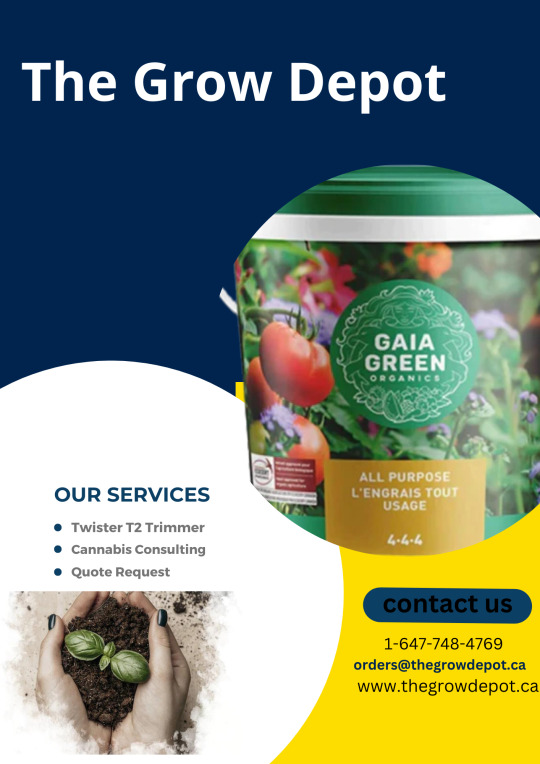
The Grow Depot
#Complete Indoor Grow Systems#Indoor Grow Room Supplies#Indoor Grow Setup For Sale#Buy Hydroponics Online#Chatham Hydroponics#Hydroponic Equipment Canada#Hydroponic Near Me
0 notes
Text


[ID: A purplish-grey stew topped with olive oil and garnished with piles of pomegranate seeds. Plates of green peppers, bitter olives, olive oil, taboon bread, green onions, radishes, and za'tar surround the dish. The second image is a close-up of the same stew. End ID]
رمانية / Rummāniyya (Palestinian pomegranate stew)
Rummaniyya (رُمَّانِيَّة; also transliterated "rumaniyya," "rummaniya," and "rummaniyeh") is a Palestinian stew or dip made from lentils, eggplant, and pomegranate seeds, flavored with nutty red tahina and a zesty, spicy دُقَّة (dugga) of dill seeds, garlic, and peppers. A طشة (ṭsha), or tempering, of olive oil and onion or garlic is sometimes added.
"Rummaniyya," roughly "pomegranate-y," comes from رُمَّان ("rummān") "pomegranate," plus the abstract noun suffix ـِيَّة ("iyya"); the dish is also known as حبّة رُمَّانَة ("ḥabbat rommāna"), or "pomegranate seeds." It is a seasonal dish that is made at the end of summer and the beginning of fall, when pomegranates are still green, unripe, and sour.
This stew is considered to be one of the most iconic, historic, and beloved of Palestinian dishes by people from Gaza, Yaffa, and Al-Ludd. Pomegranates—their seeds, their juice, and a thick syrup made from reducing the juice down—are integral to Palestinian cuisine and heritage, and images of them abound on ceramics and textiles. Pomegranates and their juice are sold from street carts and cafes in the West Bank and Gaza.
Today, tens of thousands of tons of pomegranates are grown and harvested by Israeli farmers on stolen Palestinian farmland; about half of the crop is exported, mainly to Europe. Meanwhile, Palestinians have a far easier time gaining permits to work on Israeli-owned farms than getting permission from the military to work land that is ostensibly theirs. These restrictions apply within several kilometers of Israel's claimed borders with Gaza and the West Bank, some of the most fertile land in the area; Palestinian farmers working in this zone risk being injured or killed by military fire.
Israel further restricts Palestinians' ability to work their farms and export crops by imposing tariffs, unexpectedly closing borders, shutting down and contaminating water supplies, spraying Palestinian crops with pesticides, bulldozing crops (including eggplant) when they are ready to be harvested, and bombing Palestinian farmland and generators. Though Palestinian goods have local markets, the sale of Palestinian crops to Israel was forbidden from 2007 to 2014 (when Israel accepted shipments of goods including tomato and eggplant).
Gazans have resisted these methods by disregarding orders to avoid the arable land near Israel's claimed borders, continuing to forage native plants, growing new spices and herbs for export, planting hydroponic rooftop gardens, crushing chalk and dried eggplants to produce calcium for plants, using fish excrement as fertilizer, creating water purification systems, and growing plants in saltwater. Resisting Israeli targeting of Palestinian food self-sufficiency has been necessary for practical and economic reasons, but also symbolizes the endurance of Palestinian culture, history, and identity.
Support Palestinian resistance by calling Elbit System's (Israel's primary weapons manufacturer) landlord; donating to Palestine Action's bail fund; and buying an e-Sim for distribution in Gaza.
Serves 6-8.
Ingredients:
For the stew:
1 medium eggplant (370g)
1 cup brown lentils (عدس اسود)
600g pomegranate seeds (to make 3 cups juice)
3 Tbsp all-purpose flour
1/4 cup red tahina
1/2 cup olive oil
Salt, to taste
Citric acid (ملح الليمون / حامِض ليمون) (optional)
Red tahina may be approximated with home cooking tools with the above-linked recipe; you may also toast white tahina in a skillet with a little olive oil, stirring often, until it becomes deeply golden brown.
For the دُقَّة (dugga / crushed condiment):
2 tsp cumin seeds, or ground cumin
1 1/2 Tbsp dill seeds ("locust eye" بذور الشبت / عين جرادة)
5 cloves garlic
1 green sweet pepper (فلفل بارد اخضر)
2 dried red chilis (فلفل شطة احمر)
People use red and green sweet and chili peppers in whatever combination they have on hand for this recipe; e.g. red and green chilis, just green chilis, just red chilis, or just green sweet peppers. Green sweet peppers and red chilis are the most common combination.
For the طشة (Tsha / tempering) (optional):
Olive oil
1 Tbsp minced garlic
Instructions:
1. Rinse and pick over lentils. In a large pot, simmer lentils, covered, in enough water to cover for about 8 minutes, or until half-tender.
2. Meanwhile, make the dugga by combining all ingredients in a mortar and pestle or food processor, and grinding until a coarse mixture forms.
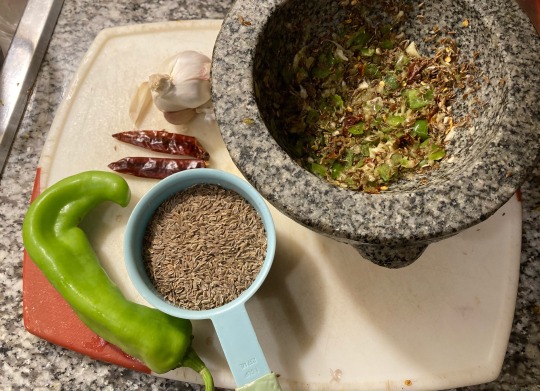
Dugga and components.
3. Cube eggplant. A medium-sized eggplant may be cut in half lengthwise (through the root), each half cut into thirds lengthwise, then cubed widthwise.
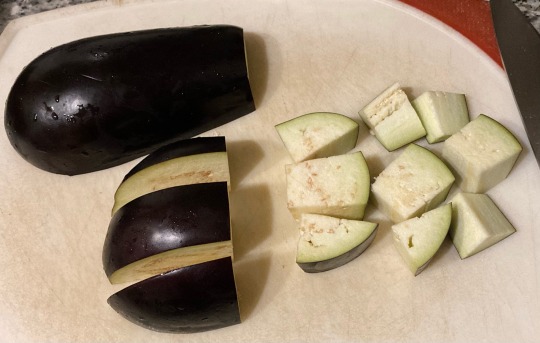
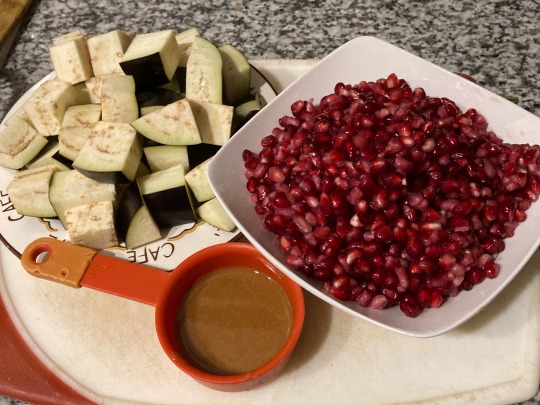
Cubed eggplant, red tahina, and pomegranate seeds.
4. Add eggplant to simmering water (there is no need to stir).
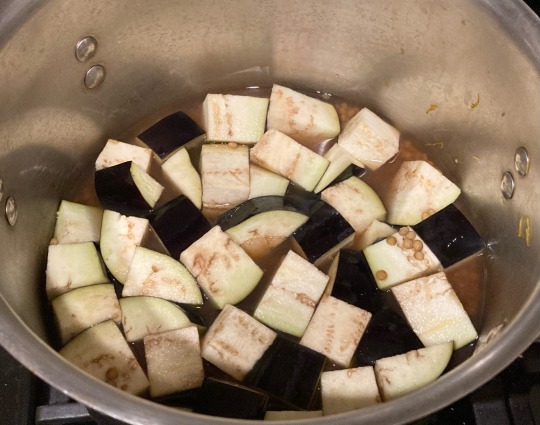
5. While the eggplant cooks, blend pomegranate seeds in a blender very thoroughly. Strain to remove any gritty residue. Whisk flour into pomegranate juice.
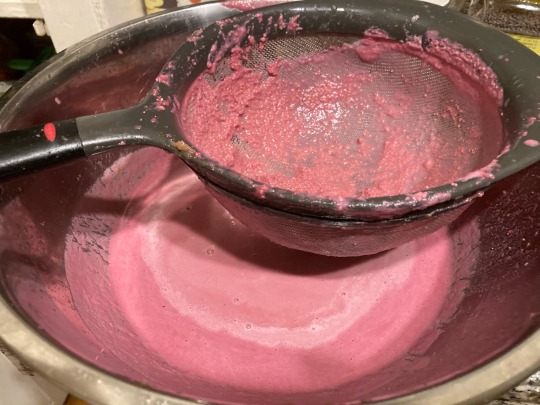
Pomegranate juice being strained.
6. Taste your pomegranate juice. If it is not sour, add a pinch of citric acid or a splash of lemon juice and stir.
7. Add dagga to the pot with the lentils and eggplant and stir. Continue to simmer until the eggplant is very tender and falling apart.
8. Add pomegranate juice, tahina, and olive oil to the pot, and simmer for another 5 minutes, or until stew is very thick and homogenous.

Bright pink pomegranate juice in stockpot.
9. (Optional) In a small skillet, heat a little olive oil on medium. Fry minced garlic, stirring constantly, until golden brown. Add into the pot and stir.
10. (Optional) Mash the stew with the bowl of a ladle or a bean masher to produce a more homogenous texture.
Serve rummaniyya hot or cold in individual serving bowls. It may be served as an appetizer, or as a main dish alongside flatbread, olives, and fresh vegetables such as radishes, green peppers, green onions, carrots, and romaine lettuce. It may be eaten with a spoon, or by using كماج (kmāj), a flatbread with an internal pocket, to scoop up each bite.
571 notes
·
View notes
Note
hey, something i've been struggling with recently is i've been struggling with "finding my people" because i'm a minority in my hometown, and a lot of people... aren't. they don't understand me, and often when i try to get them to understand they seem like they fall back into the old systems they were traumatized with (elitism, classism ect.,). 1/2 -solidarity anon

Im gunna say this at the top, this is so rough and im so sorry you gotta go through this sweetie. We are so isolated and filtered into categories within our current system in order to keep that isolation and to fight solidarity and unity. Now I cannot know for 100% sure what your going through or the extend your suffering. But will say I am from and currently still live in a oil loving, god fearing, anti-LGBT, and very racist city while i was raised wiccan by a poly core family and all my gay aunts/uncles and have been dreaming of an earthship my whole life plus every summer id be stuck in an even more harsh farming community that was so small they gotntheir first street light when i was 9 and the chruch is also town hall (mayor works in a wing off of the building). So there is at least some overlap in the experiences your having.
But that being said, how I got weirdly connected to people and involved in so many projects and stuff might not work for you.
Personally? I just yelled and yelled about the injustice of the system at work, about cool forestry projects and people buying ghost towns to start up Co-loving villages. Sharing discworld and different philosophers with coworkers backed up by their fave hobby. About how terrible the conservative politics are. About how cool transit could be if we funded it. About community art projects and how cool solar glass would make things look. About drags shows and events and did you know there is A SOUP FESTIVAL? I'm autistic and have only really interacted my whole childhood with friends with ADHD so my brain is weird and won't shut up once it starts going.
As a result of my ramblings, I have gotten a lot of responses mostly ones that are positive since if they didn't agree with my absurdist philosophy ramblings or solar project ideas they'd just leave the coffee shop. If they enjoyed it, say they want to join a community garden/event or if someone was as stoked as I was about again UNLIMITED TASTINGS SOUP FESTIVAL than we'd chat about that. The thing is a lot of these things have overlap. Someone who wants to convert their lawn into a pollinators habitate prob also likes little libraries and as a result prob also likes the idea of dark sky street lights. And down the rabbit hole you go.
That being said... my best actual advice is 2 pronged.
RESEARCH and REACH OUT
I personally have done years worth of research on my city. What local events and politics are happening? Even in rural places there is at least garderns, there's engineers, there's usually a LGBT focused club. And from these spaces, you can build a network. Doing research I found out about 5 different organizations in my city (most of which was founded 40 yrs ago??) That where sustainability focused. Doing research made me realize how cool community associations could be and how I could help mine out. It also gives you all those ideas for convos.
Second, I reached out to those groups about weird ideas I had, about if I could hang up posters for them in my local area, if I could buy groups worth of tickets in advance, and than also reaching out to the ppl I already talked to and had these ppl interact. My fave example of this is T. T is an engineer who built a fully functioning solar car during his degree program but specializes in hydroponics (how we ended up talking was over plants) he than gets shown my fave farm near by and now he's building the farms hydro system and Seedling house. Writing in to newsletter ppl and showing off weird layout design. This is ultimately very anxiety indusing. What if I'm bothering them? Why should I be spamming them like this? But the secret here is-
No one will ever be mad about you showing interest in their interest once you find those ppl. They want the interaction just as much as you do.
#sprout guide#solarpunk#community#hopepunk#connecting is so hard and swallowing differences that might seem hostile is so hard#asks#if you need more direct answers id need a more accurate idea how small/area if the place you live in sadly#so this is v broad#but feel free to DM me bout it with more details if you want
60 notes
·
View notes
Text
We're makin leaps and bounds with this whole sustainability thing since we moved from our apartment a few years ago. Whenever i feel like im not doin enough I lay out all the tiny swaps we've done on the table
we no longer by styrofoam cups and reuse the ones we have
We no longer use plastic plates, we either use glass or compostable ones (and throw the compostable ones in the compost)
Our building has solar panels for electricity
Our soaps are zero/low waste
My mother and I started our loc journey so its much easier to find all-natural, plastic free hair care
I use reusable pads
I don't buy new clothes often if at all, 4 shirts in the last 7 years
3/5 of us eat strictly plant-based bc we're vegan,
We have an indoor hydroponic system growing leafy greens, tomatoes, peppers and fruits, and we bought seeds in bulk. We're planning on swapping rockwool cubes with reusable and compostable hemp fiber cubes
Since the hydroponic system is so bright, and the led lights last for 5 years at a time, we use the living area lights much less, opting for natural sunlight if the hydroponic system is not enough or is off.
We have a bokashi indoor compost bin for food scraps, and an outdoor cold compost bin for the scraps that cant go in the bokashi bin to make our own soil
We started a kitchen garden, and a pollinator/tea garden, and as of 2023 we now have a plum tree, a grapevine, two blackberry bushes, 5 reusable grow bags, 4 big planters and 2 big raised garden beds, lookin forward to fruits and vegetables in the spring, summer, fall and winter. We're planning to buy one more steel raised bed to ensure that we are cycling through what we're growing each year to limit pest-control methods, even neem oil, and planning on purchasing a lot more perennials and native perennials/annuals.
This fall Im gonna purchase a mushroom growing chamber kit for more low waste vegan meat alternatives and to add some healthy mushroom soil to the compost cycle
Our laundry detergent is environmentally safe
Our washing machine is water-efficient
We have a fridge with a water filter for cooking and drinking water
We have reusable grocery store bags
Im gonna try to grow lufas next year to replace our kitchen sponges and steel wool scrubbing pads,
Our property is small, and our neighbors are not as social/gungho about bartering or Co-Op food gardening,
but I'm proud of wat we've done so far, and I can do a lot more, and I plan to do so, so any advice would be welcome
98 notes
·
View notes
Text
Having that manic urge to buy and grow my own strawberries again.
I. Just. Planted. Some.
Shut! Up!
Fuck off inner hobbit! I don't need more strawberry plants!!!! Nor do I need another hydroponic system (I say, as i am already setting it up currently)
By Talos, this can not be happening again—
[Dont read the tags dont–]
#i already gave in to the urge of starting a hydroponic system#AND getting some strawberry runners online#i dont NEED more strawberries#fuck my inner hobbit i dont love in the Shire#i dont NEED an urban garden#and i absolutely do NOT need chickens!!!#(also having that manic urge to start chicken husbandry or just have hens for eggs)#i am going insane#random rambles
23 notes
·
View notes
Text
Vertical Hydroponic Growing with the Lettuce Grow Farmstand: My Experience So Far
Back in July, I decided to jump into vertical hydroponics and got my hands on the Lettuce Grow Farmstand. I found it on OfferUp for an amazing deal, and I couldn’t be happier with how it’s been working out. This thing has truly transformed how I grow my veggies.
For those not familiar, the Farmstand is a modular grow tower that allows you to expand your plant capacity from 18 to 36 slots, depending on your household’s needs and cooking frequency. It’s designed to be easy to use, and let me tell you—it is! It’s basically a “set it and forget it” kind of system. Once you set it up, all you need to do is add nutrients as required, and the tower does the rest. I’ve already harvested three times since July, and I’m still blown away by how efficient this system is.
Leafy greens like lettuce and spinach have thrived the most—growing fast and providing multiple harvests. I even tried a cucumber plant, which was a fun experiment. Although it produced cucumbers, the vines ended up trailing onto the ground, so that’s something to keep in mind if you try growing heavier or more vine-prone plants.
Right now, I’ve got tamarillo, pink amaranth, Brussels sprouts, and cauliflower growing in the Farmstand, and it looks fantastic. The tower is definitely an eye-catcher once everything starts filling in. It’s been a hit with neighbors and friends, who are always asking me about it!
One of the best things about the Farmstand is how easy it is to clean and maintain. The design is simple yet effective, and I love that it’s modular—so if I ever need more space, I can easily expand. The company also offers LED Glow Rings for indoor growing, which is great for when the weather turns cold. However, I’ve been toying with the idea of making my own indoor lighting system to avoid buying their LED setup.
I’m currently working on a 3D-printed mount for LED strip grow lights that will fit around the tower, giving me full control over the lighting without the extra expense. It’s a work in progress, but I’m excited about how it will turn out and will definitely update you once I get it dialed in.
For anyone considering vertical hydroponics, I highly recommend the Lettuce Grow Farmstand. It’s a breeze to use, looks great in the garden, and delivers a continuous supply of fresh produce. Plus, it’s got me thinking creatively about how to grow indoors—without missing a beat during the colder months.
Stay tuned for more updates on my indoor growing project!
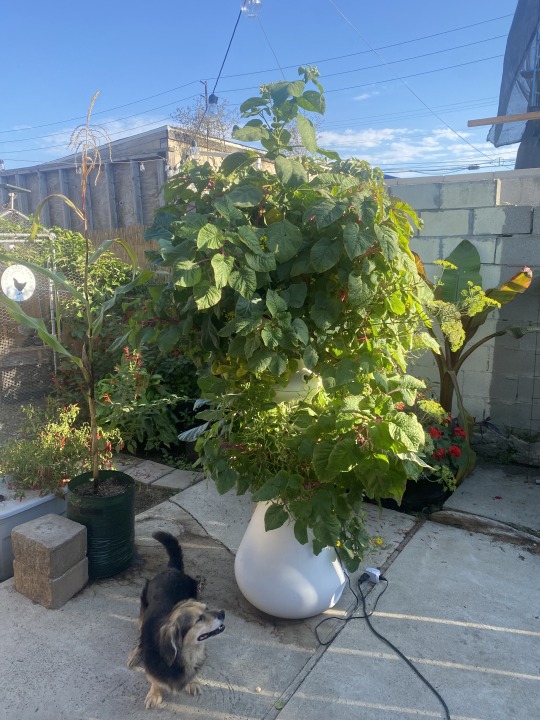

#gardening#growing#containergrowing#hydroponics#backyard chickens#kratky#girl dad#growth#chickenmath#lettuce#lettuce grow#farmstand
3 notes
·
View notes
Text
Building a DIY Hydroponic System: Unleash Your Inner Plant Scientist!
In recent years, hydroponics has gained popularity as a modern and efficient way of growing plants without soil. DIY hydroponic systems have become a favorite among gardening enthusiasts who want to take control of their food production and enjoy the benefits of fresh, pesticide-free produce. In this article, we will guide you through the process of building your own DIY hydroponic system, step by step. Whether you're a seasoned gardener or a novice, this guide will help you create a thriving indoor garden.
What is a DIY Hydroponic System?
A DIY hydroponic system is a method of growing plants in a soilless environment, using water, nutrients, and a growing medium. Instead of relying on traditional soil-based cultivation, plants are placed in a nutrient-rich water solution, allowing their roots to directly absorb the necessary elements for growth. This method provides several advantages, including faster growth rates, higher yields, and the ability to grow plants in limited space.
Benefits of a DIY Hydroponic System
Space Efficiency: DIY hydroponic systems are ideal for small spaces, as they can be tailored to fit any area, whether it's a balcony, a basement, or a spare room.
Water Conservation: Hydroponic systems use up to 90% less water compared to traditional soil-based gardening, making them an eco-friendly choice.
Year-Round Cultivation: With a hydroponic system, you can grow plants all year long, regardless of the weather conditions, extending your gardening season.
Pest and Disease Control: By eliminating soil, you reduce the risk of soil-borne pests and diseases, resulting in healthier plants.
Choosing the Right Setup
Before diving into the construction of your DIY hydroponic system, it's essential to consider the setup that suits your needs best. There are various types of hydroponic systems to choose from, including deep water culture (DWC), nutrient film technique (NFT), and drip systems. Each has its own advantages and considerations, such as space requirements, complexity, and the types of plants you can grow. Click here to buy!
Check out this tutorial to learn how to build your ebb and flow hydroponics system! DIY Ebb And Flow Hydroponic System.
Building Your DIY Hydroponic System
To build your own DIY hydroponic system, you'll need some basic materials and tools. Here's a list to get you started:
Reservoir (container to hold the nutrient solution)
Growing tray (where the plants will be placed)
Pump and tubing (to circulate the nutrient solution)
Lighting system (to provide the necessary light for plant growth)
Growing medium (to support the plants)
Nutrient solution (to provide essential plant nutrients)
Step 1: Determine the System Type
Decide on the type of hydroponic system you want to build based on your available space, budget, and personal preferences. Consider factors like ease of maintenance and the types of plants you want to grow.
Step 2: Build the Reservoir
The reservoir is where the nutrient solution will be stored. Choose a container that is large enough to accommodate your plants' needs and ensure it has a lid to prevent evaporation.
Step 3: Construct the Growing Tray
The growing tray will hold the plants and the growing medium. Construct a sturdy tray that fits your chosen system type and has proper drainage to avoid waterlogging.
Step 4: Install the Pump and Tubing
The pump and tubing will circulate the nutrient solution from the reservoir to the plants. Install them properly, ensuring the pump is reliable and the tubing reaches all areas of the growing tray.
Step 5: Set Up the Lighting
Lighting is crucial for plant growth, especially in indoor settings. Choose appropriate grow lights based on the plants you want to grow and position them at the correct height and angle to provide optimal light coverage.
Step 6: Add the Nutrient Solution
Mix the nutrient solution according to the instructions provided by the manufacturer. Fill the reservoir with the solution and monitor its pH and nutrient levels regularly to ensure healthy plant growth.
Step 7: Planting and Maintenance
Plant your chosen seeds or seedlings in the growing medium, ensuring they are properly spaced. Monitor the system regularly, checking pH levels, nutrient concentrations, and water levels. Make adjustments as necessary and prune plants when needed.
Troubleshooting Tips
If plants show signs of nutrient deficiencies or excesses, adjust the nutrient solution accordingly.
Ensure the pH levels are within the appropriate range for your chosen plants.
Keep an eye out for pests or diseases and take prompt action to prevent their spread.
Regularly clean and maintain the system to avoid clogs and blockages.
To learn how to build your vertical hydroponics system, check out this tutorial! Vertical Hydroponics DIY
Conclusion
Building your own DIY hydroponic system opens up a world of possibilities for indoor gardening. With a well-designed setup and the right care, you can enjoy fresh and healthy produce throughout the year. Experiment with different plant varieties and explore the fascinating world of hydroponics. Start your journey towards sustainable and efficient gardening today! Don't forget to choose these tools from Shopbestgoods.com!
FAQs
1. What vegetables can I grow in a DIY hydroponic system?
Leafy greens like lettuce, spinach, and kale, as well as herbs like basil and mint, are popular choices. You can also grow tomatoes, cucumbers, peppers, and strawberries.
2. How often should I change the nutrient solution?
It's recommended to change the nutrient solution every two to three weeks to maintain the proper balance of nutrients. However, monitor the solution's pH and nutrient levels regularly and adjust as needed.
3. Can I use tap water for my hydroponic system?
Tap water can be used in a hydroponic system, but it may contain chemicals like chlorine or high mineral content. It's advisable to filter or treat the tap water before using it to ensure optimal plant health.
4. Do I need to adjust pH levels in a hydroponic system?
Yes, maintaining the correct pH level is crucial for nutrient uptake by the plants. Most plants thrive in a pH range of 5.5 to 6.5. Use a pH testing kit and adjust the pH using pH-up or pH-down solutions if necessary.
5. Can I use a DIY hydroponic system for indoor gardening?
Absolutely! DIY hydroponic systems are particularly well-suited for indoor gardening. With proper lighting and care, you can enjoy the benefits of growing your own fresh produce in the comfort of your home.
#hydroponic#hydropnics#indoor gardening#indoor growing#hydroponic system#hydroponic box#ShopBestGoods#hydroponic garden#hydroponic farming
3 notes
·
View notes
Text
On the note of hydroponics, I did make a whole bunch of permit requests to build in the local caves in Gotham. Because underground farming is also an interest of mine - think about all the mushrooms you can grow!
Semi-joke aside. An underground environment also happens to be ideal for hydroponics. Natural humidity in the cave prevents desiccation and decreases water losses, while the temperature tends to be more moderate than the temperature outside - saving me on temperature control costs. These both naturally are immense cost-savings since they're literally everyday expenses. Furthermore one could also theoretically build underground as a means of expansion. It's also not as expensive as trying to buy land in the city proper.
And it's not like people cherish these caves all that much anyway, other than the random teenage spelunker.
In any case, every one of my eleven requests got rejected under the banner of environmental protection, which makes me want to laugh angrily. And when I politely requested about any cave system I could have, instead of suggesting something remotely okay like Gotham Heights or even Harborside, they suggested the cave system south of Cathedral Square? The one I specifically avoided requesting.
Why the heck would I want to develop on the strip of land directly adjacent to Blackgate Isle?!
Anyway, for a city that's so pro-business and environmentally unfriendly, I find it hilarious that cave preservation is the hill the city chooses to die on.
3 notes
·
View notes
Text
Are You Looking for the Best 100% Natural Coco Peat for Your Plants?
For gardeners looking to create lush, vibrant gardens, coco peat soil is an essential ingredient. Whether you’re cultivating flowers, vegetables, or houseplants, 100% natural and organic coco peat online from Nathan Coir is your perfect companion for sustainable gardening. Explore the benefits of this eco-friendly medium and see how it transforms your gardening experience.

Boost Plant Vitality with Coco Peat and Organic Manure Mix
When combined with homemade organic manure, coco peat soil enhances the growth and vitality of your plants. This blend provides superior moisture retention, good aeration, and excellent drainage. While commercial manure and other fertilizers can be added to further enrich the soil, it’s always best to follow the recommended ratios for each specific plant type. For larger plants, consider mixing in a small amount of soil or sand to improve stability and structure.
By choosing eco-friendly coco fiber soil, you're opting for a sustainable solution that promotes healthy plant growth while being mindful of the environment. Coco peat creates an ideal growing environment for a wide range of plants, making it a must-have for every gardener.
Why Coco Peat is Perfect for Hydroponic and Soil-free Gardening
Coco peat soil also serves as an exceptional medium for soil-less farming, especially in hydroponic systems. Whether you’re using tray-based setups or other similar hydroponic methods, coco peat supports strong root development while ensuring proper moisture retention. It’s lightweight, easy to handle, and a great alternative to traditional soil. For hydroponics or soil-free gardening, it’s a perfect choice.
Buy 100% Natural & Organic Coco Peat Online
For the best 100% organic and naturally grown coco peat available online, Nathan Coir is your go-to source.We offer everything from dry coco peat to potting mixes, ensuring that your garden gets the best foundation for growth. Check out our range of products and explore dry coco peat and potting mix on Amazon for the perfect gardening solutions.
Your One-Stop Home Gardening Shop
We offer an extensive selection of gardening products through our online home garden store. From premium-quality organic coco peat online to a wide range of plants and gardening tools, you’ll find everything you need for your garden. Our house plant shop online features a variety of plants that can brighten up any space. Whether you're setting up a new indoor garden or expanding your collection, we have just what you need for home garden online shopping.
Looking to order indoor plants online? You’ll love our wide selection of houseplants, from low-maintenance varieties to tropical beauties.We cater to all of your indoor gardening requirements, providing rapid and dependable delivery straight to your home.
Why Choose Coco Peat for Your Garden?
With its eco-friendly nature and versatile application, coco peat is an excellent choice for any gardener. By choosing organic coco peat online, you provide your plants with the best possible medium for growth. Whether you're potting houseplants, starting a vegetable garden, or setting up a hydroponic system, coco peat ensures your plants have the ideal environment to thrive.
Conclusion
At Nathan Coir, we pride ourselves on offering high-quality products that are both effective and eco-friendly. Browse our selection of organic coco peat soil, potting mixes, and more, and see how we can help you elevate your gardening experience. Whether you're new to gardening or a seasoned expert, our online store makes it easy to find everything you need for a successful garden.
#OnlineHomeGardenStore#Organiccocopeatonline#houseplantshoponline#homegardenonlineshopping#orderindoorplantsonline
0 notes
Text
Best indoor potting mix-Falaj Garden Enhance your hydroponic garden with top-quality agricultural grow lights, perfect for growing lettuce and other plants. These lights provide the ideal spectrum to boost plant growth, ensuring healthy yields in your nutrient film hydroponic system. Optimize your indoor garden with the best potting mix for indoor plants and enjoy fresh, homegrown lettuce year-round. https://falajgarden.com/product-category/potting-mediums/potting-mix/

#Best nutrients for NFT systems#Nutrient film hydroponic system#Best Potting mix home depot#Best indoor potting mix#Best potting mix for indoor plants
0 notes
Text
Find the Best Grow Bucket System in India | Farmsbazaar

The Grow Bucket System is a popular choice for hydroponic gardening, particularly among those who are new to the hobby. This system uses buckets filled with a water-based nutrient solution and mesh pots that contain the plants. The buckets are generally connected with plastic tubing and a pump to keep the nutrient solution moving.
#Hydroponic Systems#Hydroponic System Indoor#Buy Hydroponic Systems#Hydroponic systems for sale#Low maintenance hydroponic systems#Hydroponic System For Home#Best Indoor Hydroponic grow system#Vertical NFT Hydroponic Systems#Vertical nft System#Hydroponic Microgreens System#Grow Bucket System
1 note
·
View note
Text
Unlocking Growth Potential with Hydroponic Lighting in Gosford
Hydroponic farming is revolutionizing agriculture, enabling efficient and sustainable plant growth without soil. A crucial aspect of a successful hydroponic system is lighting, as it mimics natural sunlight to promote healthy plant development. In Gosford, where indoor and greenhouse farming is gaining popularity, understanding hydroponic lighting is essential. This guide explores the importance of hydroponic lighting, its types, and tips for selecting the best hydroponic lighting in Gosford.
1. What Is Hydroponic Lighting and Why Is It Important?
Hydroponic lighting is designed to replicate or enhance natural sunlight, providing plants with the energy needed for photosynthesis. Here’s why it’s vital:
Controlled Environment: Ideal for indoor farming where natural light is insufficient.
Extended Growing Seasons: Enables year-round growth regardless of outdoor weather.
Optimized Plant Growth: Specific light spectrums can target growth stages, from germination to flowering.
In Gosford, where indoor gardening is thriving, investing in quality lighting is a game-changer for hydroponic growers.
2. Types of Hydroponic Lighting
Understanding the types of hydroponic lighting can help you choose the best system for your needs:
a. LED Grow Lights
Energy Efficient: Consumes less power compared to traditional lights.
Customizable Spectrum: Tailored light wavelengths for specific plant stages.
Durability: Longer lifespan than other lighting types.
b. High-Intensity Discharge (HID) Lights
Powerful Illumination: Ideal for large-scale setups.
Two Types: Metal Halide (MH) for vegetative growth and High-Pressure Sodium (HPS) for flowering.
c. Fluorescent Lights
Budget-Friendly: Affordable and easy to set up.
Lower Intensity: Best suited for small-scale or beginner growers.
d. Compact Fluorescent Lights (CFLs)
Compact Design: Fits into smaller spaces.
Versatile: Suitable for starting seedlings and herbs.
3. Choosing the Right Hydroponic Lighting in Gosford
Selecting the right lighting depends on factors like the type of plants, growing space, and budget.

Assess Plant Needs: Determine whether your crops require more red or blue light spectrums.
Calculate Space Requirements: Ensure the lighting system covers your entire grow area.
Consider Energy Efficiency: Opt for LED lights to save on electricity costs in the long run.
Budget Wisely: Start with an affordable option like fluorescent lights if you're a beginner.
4. Benefits of Hydroponic Lighting for Gosford Grower
Gosford’s climate makes hydroponic systems a popular choice for local growers. Here’s how hydroponic lighting helps:
Enhanced Crop Yield: Consistent light exposure promotes faster and healthier growth.
Pest Control: Indoor systems reduce the risk of pests and diseases.
Space Utilization: Grow vertically with stacked systems and proper lighting.
Sustainability: Hydroponic systems with efficient lighting use less water and energy.
5. Where to Buy Hydroponic Lighting in Gosford
Gosford is home to several specialty stores catering to hydroponic enthusiasts. Look for:
Local Hydroponic Shops: Expert advice and tailored recommendations.
Online Retailers: Convenient access to a wide range of products.
Garden Supply Stores: Often stock beginner-friendly lighting systems.
Some stores even offer installation services and after-sales support to help you get started.
6. Tips for Maximizing Hydroponic Lighting Efficiency
To get the most out of your hydroponic lighting system, follow these tips:
Use Reflectors: Maximize light distribution to cover all plants.
Maintain Light Distance: Place lights at an optimal height to avoid scorching plants.
Schedule Lighting: Mimic natural day-night cycles with timers for consistent growth.
Regular Cleaning: Keep lights and reflectors clean to maintain their efficiency.
Conclusion
Hydroponic lighting is an indispensable component of indoor and greenhouse farming in Gosford. By selecting the right lighting system and optimizing its use, you can enjoy abundant, year-round harvests. Whether you’re a seasoned grower or a beginner, investing in hydroponic lighting will elevate your farming efforts, ensuring healthy plants and increased yields. Explore your options today and unlock the full potential of hydroponic gardening in Gosford!
0 notes
Text
Hydroponics Market Forecast 2025-2033: Growth Insights

Hydroponics Market Research Report
Market Strides has recently added a new report to its vast depository titled Global Hydroponics Market. The report studies vital factors about the Global Hydroponics Market that are essential to be understood by existing as well as new market players. The report highlights the essential elements such as market share, profitability, production, sales, manufacturing, advertising, technological advancements, key market players, regional segmentation, and many more crucial aspects related to the Hydroponics Market.
Get Free Sample Report PDF @ https://marketstrides.com/request-sample/hydroponics-market
Hydroponics Market Share by Key Players
Nelson and Pade
Aquaponic Source
Backyard Aquaponics
Aquaponics USA
PentairAES
Gothic Arch Greenhouses
Stuppy
ECF Farm Systems
Urban Farmers
PFAS
EcoGro
Aquaponic Lynx
Aquaponics Place
Endless Food Systems
Aonefarm
Japan Aquaponics
Evo Farm
Water Farmers
Hydroponics Market Segmentation
The report on Global Hydroponics Market provides detailed toc by type, applications, and regions. Each segment provides information about the production and manufacturing during the forecast period of 2025-2033 . The application segment highlights the applications and operational processes of the industry. Understanding these segments will help identify the importance of the various factors aiding to the market growth.
The report is segmented as follows:
By Type
Media Filled Growbeds (MFG
By Application
Academic
Commercial
Family
Get Detailed @ https://marketstrides.com/report/hydroponics-market
Hydroponics Market Frequently Asked Question
1) What are Hydroponics Market and why are they important?
2) What is the future outlook for the Hydroponics Market?
3) What are the Segments Covered in the Market?
4) Who are the prominent key players in the Market?
Key Highlights
It provides valuable insights into the Hydroponics Market.
Provides information for the years 2025-2033. Important factors related to the market are mentioned.
Technological advancements, government regulations, and recent developments are highlighted.
This report will study advertising and marketing strategies, market trends, and analysis.
Growth analysis and predictions until the year 2032.
Statistical analysis of the key players in the market is highlighted.
Extensively researched market overview.
Buy Hydroponics Market Research Report @ https://marketstrides.com/buyNow/hydroponics-market
Contact Us:
Email : [email protected]
#Hydroponics Market Size#Hydroponics Market Share#Hydroponics Market Growth#Hydroponics Market Trends#Hydroponics Market Players
0 notes
Text
Bluelab PeriPod For Hydroponics

Buy Bluelab PeriPod to optimise nutrient solutions effortlessly for healthier hydroponic yields. The PeriPod M4 is a versatile dosing and control system for precise nutrient and pH levels.
0 notes
Text
Implement Premium Advanced Nutrients Organic from Reliable Source
If your garden plants lack a strong root and yield, go for advanced nutrients organic. It helps grow a vibrant and rich root system. Organic fertilizers provide the required nutrition that can boost the crop yield effectively.
Nurture the growing medium effectively to boost the plants' nutrient absorption level. This is where advanced nutrients organic and suitable for use. Try to source it from a reliable manufacturer. It is to ensure that the quality will not be compromised. Investing in this organic nutrient is a way to boost the yield quality.
It boosts the fertility of the crops and nourishes beneficial microbes
It strengthens the root system, boosting the growth and help grow fresh crops
So, the nutrient is a suitable one to facilitate plant growth in the hydroponic media. Elevate the standards of organic production and ensure quality and timely production.

Buying advanced nutrients organic Online
If you wish to get advanced nutrients organic online, try to get it from a reputable and reliable source. Check the ingredients in the nutrient for the right amount to help in plant growth. A reputable retailer can ensure proper manufacturing and quality of the end product.
Why Use Advanced Nutrients Bud Candy in Plants?
The advanced nutrients bud candy is a nutrient source that helps plants flower in full form. It is a perfect mix of carbohydrates and magnesium. It helps plants get the best-growing environment and have quality yields. The nutrient content also boosts the roots and strengthens them to offer quality yields.
The carbohydrates in advanced nutrients bud candy boost the yield quality. It also contains magnesium. It creates the right growing conditions and boosts the photosynthetic capacity of the plant. For quality advanced nutrients bud candy, HydroWorlds is a reliable source.
0 notes